Introduction
Organizing a farmers’ market requires many resources. One of the most valuable resources is the volunteers that contribute their time, knowledge and passion. While there may be a dedicated core group of farmers’ market organizers, additional volunteers are needed to help ensure a successful farmers’ market and prevent volunteer burnout.
This fact sheet offers strategies that can be applied to develop and retain a farmers’ market volunteer base. These strategies were used successfully with a farmers’ market that began with a few local volunteers in a small, remote town. Within four years, the Tonopah Farmers’ Market grew to about thirty-five volunteers and 250 attendees each week. Specific examples from the Tonopah Farmers Market will be highlighted throughout this publication.
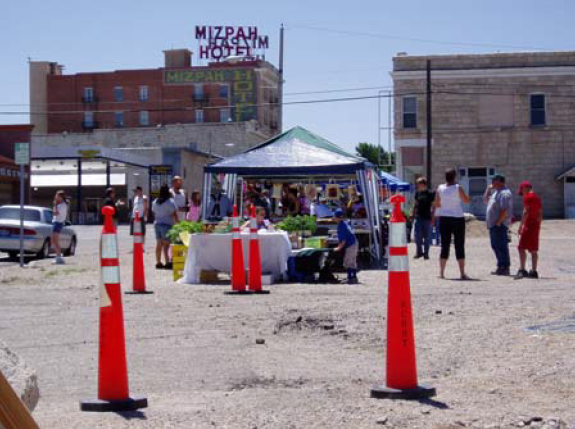
2005 Opening Day, Tonopah Farmers Market
Recruiting & Retaining Volunteers
The University of Wisconsin-Extension (2008) offers a practical model to follow, in order to support efforts to recruit and retain volunteers.
Identifying program needs and designing volunteer roles are two early steps, which should take place prior to recruiting volunteers for a farmers’ market. This will help ensure that essential duties are clear and can be completed by volunteers. Recruitment follows in the volunteer staffing cycle.
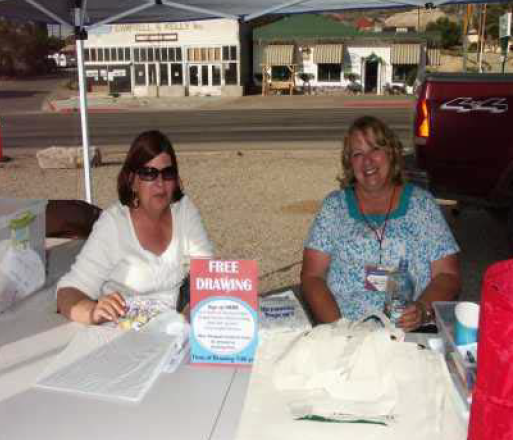
22% of Nevadan volunteers are 35-44 years old (Tingey, 2008)
Why do people volunteer?
When building a volunteer base for a farmers’ market, it is valuable to be aware of reasons why people volunteer and best practices for recruiting and retaining volunteers.
Research shows (Skelly, 2000) the reasons people volunteer in their community often include: working with others, acquiring new knowledge, learning new job skills or prestige. All Tonopah Farmers’ Market volunteers who completed a 2008 volunteer impact questionnaire indicated that they donated their time because they wanted to make their community a better place to live.
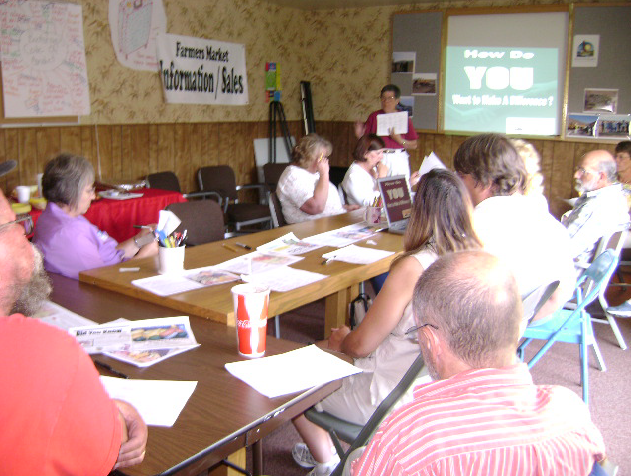
2008 Volunteer Orientation Event
Strategies for Recruitment
There are many strategies for recruiting new volunteers. Commonly practiced methods include flyers, newspaper ads and radio announcements. Word-of-mouth and volunteer kick-off events are very effective ways to recruit volunteers, particularly in small towns where there may not be a local radio station or daily newspaper. Volunteer orientation and training are critical steps in the volunteer staffing cycle.
A volunteer orientation event is a great way to recruit new volunteers. Oftentimes, people are hesitant to volunteer because they don’t realize how important their role is or they don’t know what tasks need to get done. They may feel daunted by the amount of work that needs to be done, so breaking up volunteer jobs into specific duties and time commitments is recommended.
At a volunteer orientation event for the Tonopah Farmers’ Market, organizers gave a brief presentation of the history of the market and rewards of volunteering. They provided descriptions of volunteer jobs and the skills needed. They obtained volunteer commitments for specific jobs and dates and handed out gifts to people who committed to volunteering. As a result, the farmers’ market committee gained 21 new volunteers.
Volunteers need training to build skills and confidence. After the orientation session for volunteers, organizers of the Tonopah Farmers’ Market provided training for working at information booth, setting up the canopies and market clean-up. This helped to minimize chaos on opening market day and ensured volunteers knew what was expected of them.
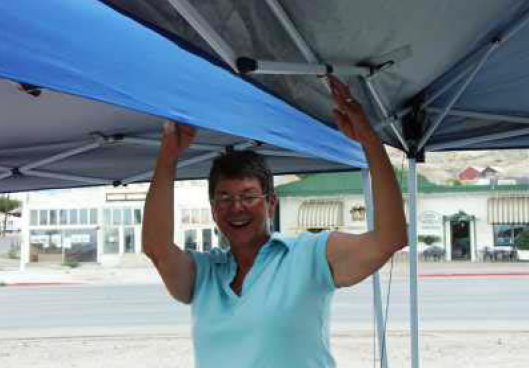
New volunteer setting up canopies
Strategies for Retaining Volunteers
Recruiting volunteers for a farmers’ market is only half the battle. Ensuring that volunteers have a positive experience and want to continue being active in the farmers’ market are key components to developing a vibrant and long-term volunteer base. Retaining volunteers, particularly market managers, is a key factor in successful farmers’ markets (Stephenson, Lev, and Brewer, 2008).
Since grassroots farmers’ markets rely so heavily on their volunteer resources, it becomes essential to discover what drives each individual volunteer in order to cater to their motivations and help ensure that they remain as long-term volunteers. The organizers of the Tonopah Farmers’ Market took time to talk with each potential volunteer to find what motivated them, and tried to cater to what volunteers need throughout the season.
Another step in the cycle of volunteer staffing is to provide support and evaluation throughout the volunteer service. It is not uncommon in small towns for volunteers to be stretched between different organizations or programs. Key volunteers can get burned out or discouraged, particularly if they are active in both the pre-season planning and in the weekly market activities. Checking in with volunteers and encouraging them to share ideas for improvement of the farmers’ market, or to even take a week off from volunteering, is a good investment.
It is also important to recognize the work of farmers’ market volunteers. As previously noted, volunteers are highly motivated to improve their community. The benefits of farmers’ markets are vast, including economic development, building community cohesion, encouraging intergenerational interactions and having fresh and healthy food available locally (Ostrom and Lyons, 2007). Be sure to point out to volunteers that they are contributing to these efforts.
When volunteers do a good job, it is important to recognize them and provide an opportunity for them to have increased responsibility if they so desire. Volunteer recognition could be done using public media, at a meeting, at the farmers’ market or at another special event.
The Tonopah Farmers’ Market holds a special celebration with all their volunteers at the end of the season. Organizers play a slide show with pictures of volunteers working at the market. Small gifts of appreciation are given to each volunteer. There are also a few short speeches re-capping the season and highlighting a few outstanding volunteers.
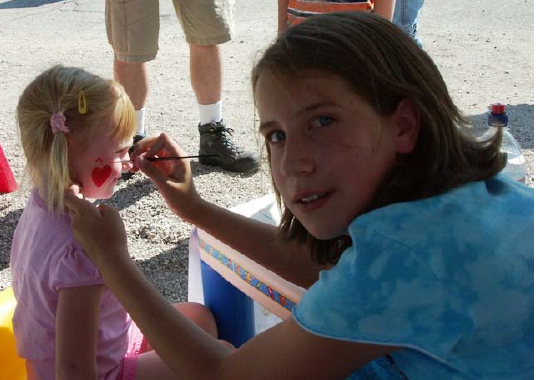
Volunteer at children’s story-time booth
Conclusion
Local volunteers are valuable resources that are needed to sustain a successful farmers’ market. It is essential to actively recruit and train volunteers to ensure that they get what they need out of their volunteer experience and can provide the skills needed to sustain the event. The Tonopah Farmers’ Market offers us examples of effective strategies that others may use to recruit and retain volunteers.
References
Ostrom, M. and Lyons, Z. Washington State Farmers Market Manual. Washington State Department of Agriculture. 2007. AGR PUB 200- 189.
Skelly, J. A. Motivating Volunteers. University of Nevada Cooperative Extension. 2000. FS-00-30. Access online: UNCE.
Stephenson, G., Lev, L., and Brewer, L., When Things Don’t Work: Some insights into why farmers’ markets close. Oregon State University Extension Service. 2008. Special Report 1073-E. Website: OSU site.
Tingey, J. Volunteerism in Nevada: Trends and Implications. 2008. Presented 2/22/08. Updated 5/12/08.
University of Wisconsin-Extension. 4-H Volunteer Leader Roles.2008. Accessed September 3, 2008 from UW site.
Meier, A.
2008,
Developing Farmers’ Market Volunteers (2008),
Extension | University of Nevada, Reno, FS-08-48


